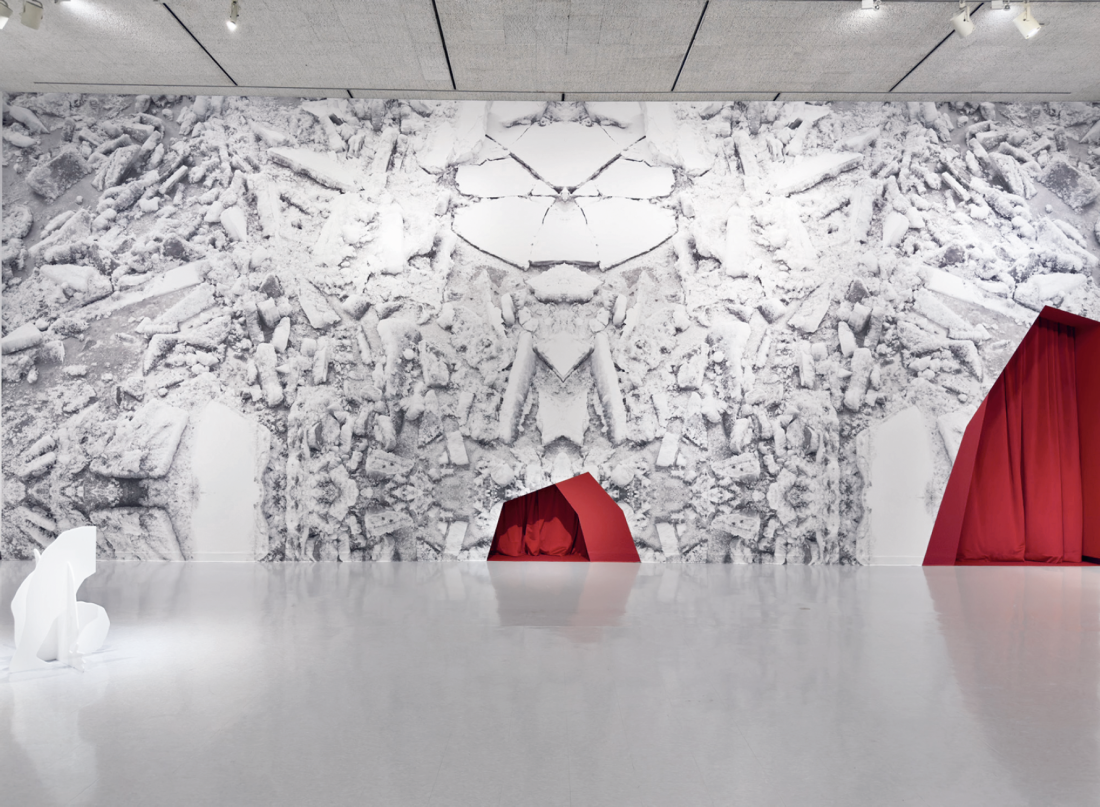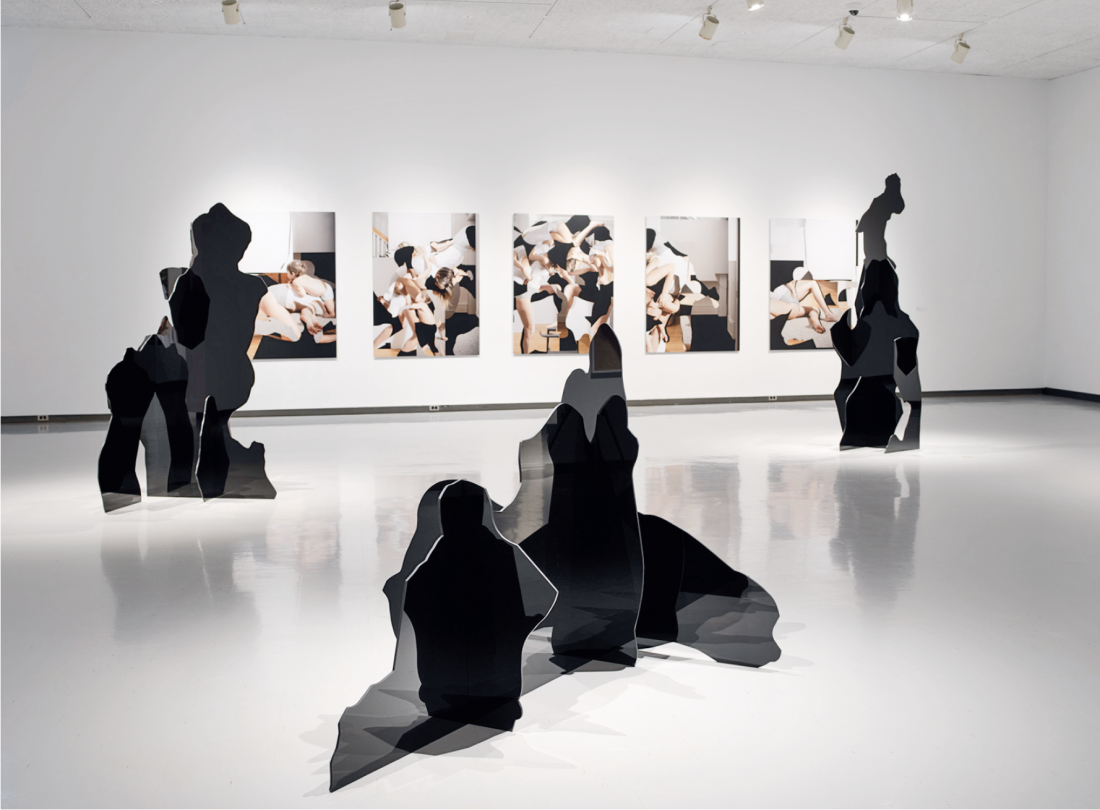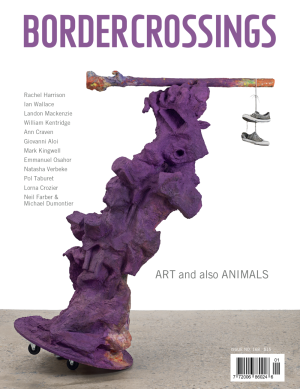Dominique Rey
“The experience of motherhood loses nearly everything in its translation,” writes author Rachel Cusk in her parenting memoir, A Life’s Work. In “MOTHERGROUND,” a recent solo exhibition at the Winnipeg Art Gallery, Franco-Manitoban artist Dominique Rey seeks to recover this loss by refracting her own experience of parenting through nimble formal experimentation. Spanning photography, collage, sculpture and video installation, Rey’s work articulates a version of motherhood defined by the physical and psychological porousness between parent and child. The artist’s own children, Madeleine and Auguste, feature prominently in the work and are co-credited as collaborators, flooding the shrewdly oblique body of work with an acutely personal dimension that merges the acts of caretaking and creation.
Just beyond the exhibition’s threshold hangs a painting of the Madonna and Child, the iconic image of motherhood, which illustrates psychoanalyst Helene Deutsch’s claim that “mothers don’t write; they are written.” Despite mounting evidence to the contrary—figures like Rey and Cusk contribute to a growing trend in art and literature that foregrounds the lived experience of motherhood— the ideal of the passive mother endures. This vision has held fast even as contemporary representations, from the second wave of feminism onward, have challenged this model in favour of more candid ones that acknowledge the burden of domestic labour that mothers disproportionately bear. Curiously, “MOTHERGROUND” belongs to neither of these traditions. Rey’s exhibition offers a re-enchantment of motherhood, a desacralized counterpart to the Madonna, stripped of the baggage of divinity but detached from the stark realism that has dominated in recent decades.

Dominique Rey with Madeleine and Auguste Coar, installation view, “MOTHERGROUND,” 2024–2025, WAGQaumajuq, Winnipeg. Photo: Dominique Rey. Courtesy WAG-Qaumajuq, Winnipeg. Background: curtain wall installation, 2024, 541.02 × 1280.16 centimetres. Foreground: Shadows Bathing in the Sun, 2024, white acrylic, 91.44 × 65.23 × 61.29 centimetres.
Pinpointing Rey’s exact idea of motherhood is difficult to do without lapsing into woefully Janus-faced language. Take “Domestic Frieze,” for instance: a series of collages that feels paradoxically suspended between grace and chaos. Composed of fragmented photos of Rey and her children captured mid-tumble, the images are haphazardly assembled into a jumble of limbs and glimpses of the family home. The linear arrangement of these five works casts motherhood as an identity in motion, a process of continual reorientation and negotiation between kin. It’s unclear whether we are witnessing a struggle or play, but, regardless, what transpires is a sense of unbridled joy in this rewilding of the domestic realm.
Those familiar with Rey’s work will recognize the hallmarks of her practice: a proclivity to invert figure-ground relationships and conceal subjects through costume and collage. Rey avoids shortcuts to intimacy (such as the gaze) and instead works ambiguity to her advantage by withholding details and inviting viewers to cast their own emotional attachments into the scene. This sense of indeterminacy is aided by Rey’s material restlessness, which consistently pushes images toward the brink of legibility, culminating in a stunning series of largescale acrylic sculptures composed of interlocking silhouettes of the artist and her children. Depending on the viewer’s angle, the sculptures reveal shifting contours: an elbow from one side, the outline of a face from another. Nearly everyone will enter the gallery with their own personal baggage about mothers, and these Rorschach-esque forms provide an ideal surface for projection, teasing out a latent psychoanalytic undercurrent.
“In Case of Storms,” a visually spare but striking series of photographs, depicts the profile of a visibly pregnant Rey embracing her daughter. Overlaid within the boundaries of the artist’s body are ice fragments spliced from photos of Winnipeg’s partially frozen Red River—a motif echoed in floor-toceiling wallpaper at either end of the gallery and several collages. While the wall text simply states that “ice is a metaphor for impermanence,” it’s tempting to read the melting forms as reflections of existential anxieties in an era of polycrisis. This dogged effort to maintain hope in spite of evidence to the contrary resonates with mothers and non-mothers alike, but the stakes are made particularly clear in the image of Madeleine’s figure burrowing into the river ice-mother.

Dominique Rey with Madeleine and Auguste Coar, installation view, “MOTHERGROUND,” 2024–2025, WAGQaumajuq, Winnipeg. Photo: Dominique Rey. Courtesy WAG-Qaumajuq, Winnipeg. Wall: “Domestic Frieze,” 2024, archival pigment print mounted to Dibond, 162.56 × 609.6 centimetres. Left to right: Midnight Sun, 2024, black acrylic, 198.12 × 123.04 × 134.37 centimetres; Overlay, 2024, black acrylic, 123.75 × 159.11 × 241.3 centimetres; Holding Time, 2024, black acrylic, 243.84 × 96.27 × 82.42 centimetres.
Just as the melting ice hovers between a solid and liquid state, “MOTHERGROUND” transitions between reality and fantasy, banality and profundity—a set of contrasts analogized through the dynamic between figure and ground. These tensions come to a head in the eponymous video installation, which serves as a climactic synthesis of the work’s visual themes and emotional range. Clad in variations of patterned unitards, Rey and her children perform improvised movements against matching backdrops while strobe lights, red fog and a sweeping orchestral score drive the ambience to a dramatic breaking point. Until now, movement has been only implied, faces have remained mostly obscured and moods have surfaced only in brief flashes. Evidently, Rey knows how to leverage the potential of her various media, and here she uses abrupt changes in music and lighting to cue tonal shifts and guide the viewer toward a particular emotional response, taking the vibe from mellow to suspenseful before settling back into a low-energy torpor. Unlike the more open-ended works, the immersive environment of the video—installed in a crimson-red theatre with childfriendly architectural detailing— trades some of the show’s enigmatic energy for a well-choreographed maelstrom of softness, agility and playful aggression. There’s a sense of grandeur in this finale that shatters any stubborn clichés that assume art about mothering must be meek or mild-mannered.
Any artist exploring motherhood as a theme invariably faces the assumption that artistic production and parenting are mutually exclusive. Curator Riva Symko addresses this head-on in the exhibition catalogue, highlighting the conflicting demands of art making and parenthood. As a subject, mothering is often perceived as either culturally conservative or, worse, sentimental, and those who tackle it tend to respond with an almost overcompensatory detachment. Motherhood as a topic feels especially at home in Rey’s practice, which has forged a niche for illuminating aspects of female identity beyond the limits of language. Rey presents a nuanced but warm vision of motherhood unbound by either iconography or polemic. If, as Cusk suggests, motherhood is defined by its inexpressibility, “MOTHERGROUND” reframes the proposition: it’s no longer about what is lost in translation but what can be found. ❚
“Dominique Rey: MOTHERGROUND” is exhibiting at the Winnipeg Art Gallery, Winnipeg, from October 12, 2024, to June 28, 2025.
Madeline Bogoch is a writer and film programmer based in Winnipeg.

